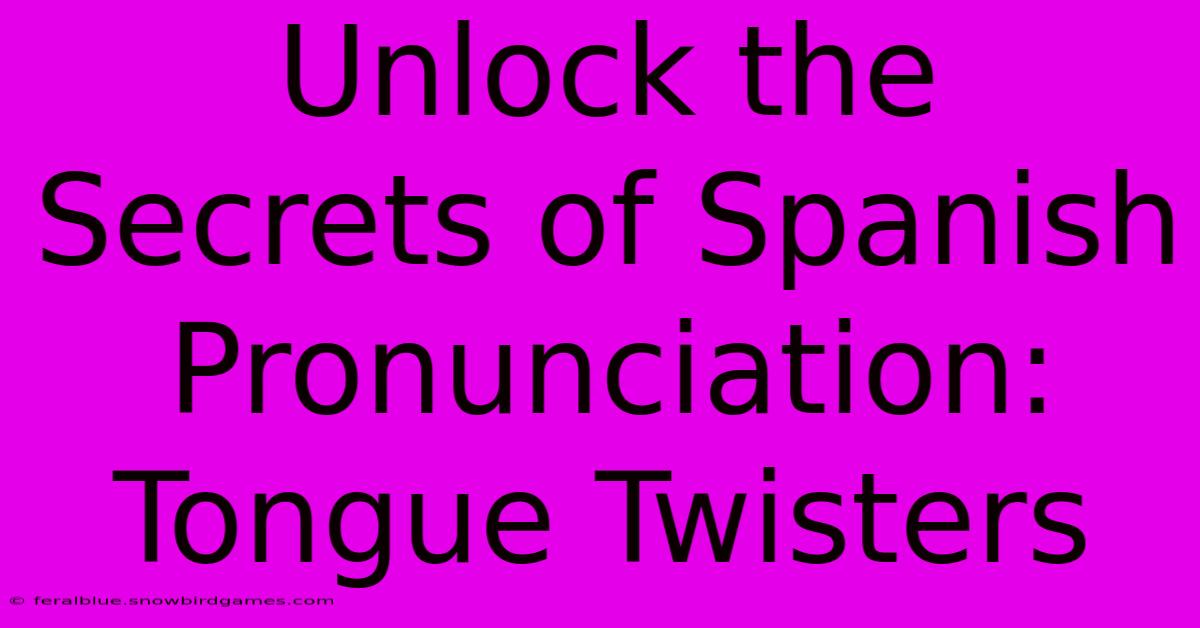Unlock The Secrets Of Spanish Pronunciation: Tongue Twisters

Table of Contents
Unlock the Secrets of Spanish Pronunciation: Tongue Twisters
Learning a new language is an exciting journey, and mastering pronunciation is a crucial step. Spanish, with its beautiful sounds and rhythmic flow, can seem daunting at first, but don't worry! One fun and effective way to improve your Spanish pronunciation is by tackling tongue twisters – trabalenguas in Spanish. These playful phrases can help you hone your skills, improve your fluency, and unlock the secrets to clear and confident Spanish speech.
Why Use Tongue Twisters for Spanish Pronunciation?
Tongue twisters are more than just a fun challenge; they're a powerful tool for language learning. Here's why they're so effective for improving your Spanish:
- Improved Articulation: Repeating tongue twisters forces you to practice precise mouth movements and tongue placement, leading to clearer articulation of individual sounds.
- Enhanced Muscle Memory: Regular practice builds muscle memory in your mouth and tongue, making it easier to produce sounds correctly without conscious effort.
- Increased Fluency: As you become more comfortable with the sounds, your fluency will naturally improve, allowing you to speak more smoothly and confidently.
- Fun and Engaging: Let's face it, learning can be tedious. Tongue twisters make the process fun and engaging, keeping you motivated to practice.
- Identifying Problem Sounds: Struggling with a particular tongue twister often highlights specific sounds or combinations that you need to focus on improving.
Easy Spanish Tongue Twisters for Beginners
Start with these simple trabalenguas to build your confidence:
- Pablito clavó un clavito. (Pablo hammered a little nail.) This one focuses on the "p" and "cl" sounds.
- El perro de San Roque no tiene rabo. (The dog of San Roque has no tail.) Practice the "r" sound.
- Tres tristes tigres tragaban trigo en un trigal. (Three sad tigers were eating wheat in a wheat field.) Focus on the "tr" sound.
Tips for Mastering These Tongue Twisters:
- Start Slowly: Don't rush! Begin by saying the twister slowly and deliberately, focusing on each sound.
- Repeat Frequently: Practice each twister multiple times throughout the day. The more you repeat it, the easier it will become.
- Record Yourself: Recording yourself helps you identify areas where you need improvement.
- Listen to Native Speakers: Listen to native speakers pronounce the tongue twisters to model your pronunciation.
Challenging Spanish Tongue Twisters for Intermediate Learners
Once you've mastered the basics, try these more difficult trabalenguas:
- Si seis cerdos se sientan sobre seis sacos de seis sesos, ¿sobre cuántos sesos se sientan seis cerdos? (If six pigs sit on six sacks of six brains, on how many brains do six pigs sit?) This one is great for practicing the "s" sound and sentence structure.
- Dime, doce cabras, ¿cuántas cabras son doce cabras? (Tell me, twelve goats, how many goats are twelve goats?) This focuses on the sounds “d,” “c,” and “br.”
- Erre con erre, guitarra; erre con erre, barril; rápido corren los carros, rápido corren por el ferrocarril. (R with r, guitar; r with r, barrel; quickly the cars run, quickly they run along the railroad.) This is a classic that focuses on the tricky "r" sound in different contexts.
Advanced Tips for Intermediate and Advanced Learners:
- Break It Down: Divide the tongue twister into smaller phrases to focus on individual sections.
- Focus on Rhythm: Pay attention to the rhythm and intonation of the sentence.
- Vary Your Pace: Try saying the tongue twister at different speeds—slowly for precision and quickly for fluency.
- Engage with Others: Practice with a language partner or tutor to receive feedback and improve your pronunciation.
Beyond Tongue Twisters: Additional Tips for Spanish Pronunciation
While tongue twisters are a fantastic tool, they are just one part of the equation. Remember to:
- Focus on Individual Sounds: Practice individual sounds (phonemes) that are particularly challenging for you.
- Utilize Online Resources: Many websites and apps offer audio recordings and pronunciation guides.
- Immerse Yourself in the Language: Surround yourself with the Spanish language through movies, music, and podcasts.
- Practice Regularly: Consistent practice is key to improving your Spanish pronunciation.
By incorporating tongue twisters into your Spanish learning routine, you'll improve your articulation, enhance your fluency, and increase your overall confidence in speaking Spanish. So, embrace the challenge, have fun with it, and enjoy the journey towards mastering this beautiful language! ¡Buena suerte! (Good luck!)

Thank you for visiting our website wich cover about Unlock The Secrets Of Spanish Pronunciation: Tongue Twisters. We hope the information provided has been useful to you. Feel free to contact us if you have any questions or need further assistance. See you next time and dont miss to bookmark.
Featured Posts
-
Age Calculator In Bs Instant Age Calculation
Apr 04, 2025
-
Rampage Jacksons Son The Complete Story
Apr 04, 2025
-
Rohit Sharma Net Worth And Charitable Contributions
Apr 04, 2025
-
Gary Sinises Sons Cancer Finding Strength In Faith
Apr 04, 2025
-
Age Of Empires 3 Hile No More Frustration
Apr 04, 2025
